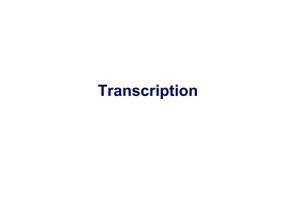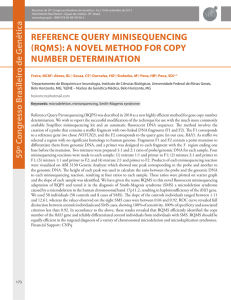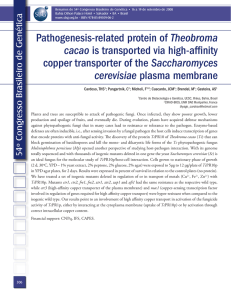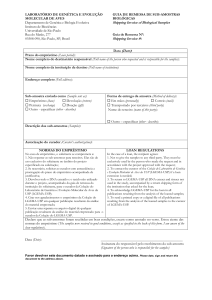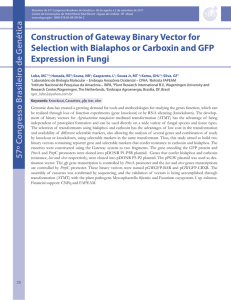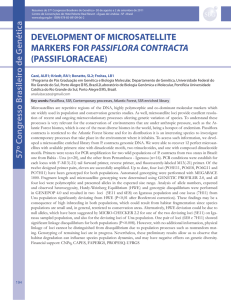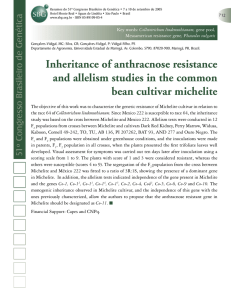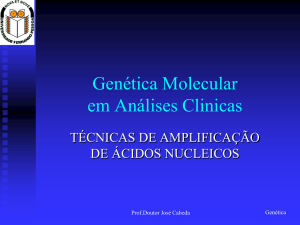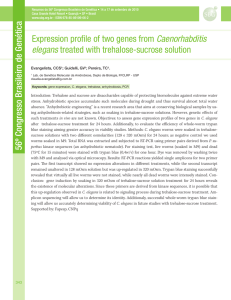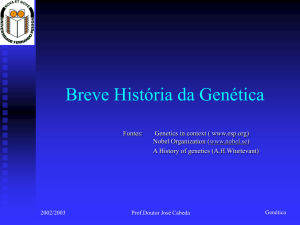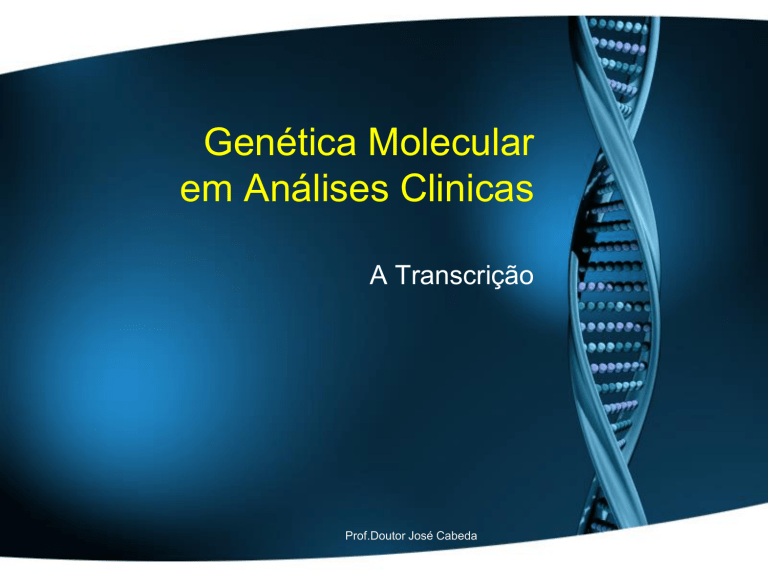
Genética Molecular
em Análises Clinicas
A Transcrição
Prof.Doutor José Cabeda
A Transcrição
•
•
•
•
•
•
O RNA como espécie central na genética
Tipos de polimerases do RNA. Cofactores
Promotores
Mecanismo da Transcrição
Papel da instabilidade do RNA.
Transcrição reversa
O RNA no cerne da Genética
• Transcrição
– produção de mRNA
– A regulação génica depende da semivida do
mRNA
• Primers de RNA na replicação
• O tRNA intervem na tradução
• O rRNA intervem na tradução
• Alguns vírus só utilizam o RNA
A Transcrição
•
•
•
•
•
•
O RNA como espécie central na genética
Tipos de polimerases do RNA. Cofactores
Promotores
Mecanismo da Transcrição
Papel da instabilidade do RNA.
Transcrição reversa
Polimerases do RNA
• Eucariotas:
– Tipo I – rRNA (50-70%)
– Tipo II – hnRNA (20-40%; mRNA)
– Tipo III – restantes espécies de RNA
(10%;tRNA, snRNA)
– Mitocondrias
– Cloroplastos
• Formadas por várias subunidades com
funções específicas
A Transcrição
•
•
•
•
•
•
O RNA como espécie central na genética
Tipos de polimerases do RNA. Cofactores
Promotores
Mecanismo da Transcrição
Papel da instabilidade do RNA.
Transcrição reversa
Promotores
A Transcrição
•
•
•
•
•
•
O RNA como espécie central na genética
Tipos de polimerases do RNA. Cofactores
Promotores
Mecanismo da Transcrição
Papel da instabilidade do RNA.
Transcrição reversa
Pol é posicionada
por TBP
Iniciação da transcrição
animação
Abertura da hélice
Transcrição (animação)
• Fase de iniciação
– Reconhecimento do DNA e
posicionamento
– Abertura da hélice
– Incorporação do primeiro nucleótido
• Fase de elongação
– Migração da zona de DNA aberto
– Elongação do hnRNA
• Fase de terminação
Transcrição
• Processamento do RNA (animação)
– Adição do CAP
– Poliadenilação
– splicing
mRNA
animação
A Transcrição
•
•
•
•
•
•
O RNA como espécie central na genética
Tipos de polimerases do RNA. Cofactores
Promotores
Mecanismo da Transcrição
Papel da instabilidade do RNA.
Transcrição reversa
A Transcrição
•
•
•
•
•
•
O RNA como espécie central na genética
Tipos de polimerases do RNA. Cofactores
Promotores
Mecanismo da Transcrição
Papel da instabilidade do RNA.
Transcrição reversa
Regulation of Transcription Initiation
Bacterial gene control: the Jacob-Monod
model
Copyright (c) by W. H. Freeman and Company
Experimental evidence for cis-acting DNA
sequences
Copyright (c) by W. H. Freeman and Company
Experimental evidence for trans-acting
genes/proteins
Copyright (c) by W. H. Freeman and Company
Bacterial transcription initiation
• RNA polymerase initiates transcription of most genes at a unique
DNA position lying upstream of the coding sequence
• The base pair where transcription initiates is termed the
transcription-initiation site or start site
• By convention, the transcription-initiation site in the DNA sequence
is designated +1, and base pairs extending in the direction of
transcription (downstream) are assigned positive numbers which
those extending in the opposite direction (upstream) are assigned
negative numbers
• Various proteins (RNA polymerase, activators, repressors) interact
with DNA at or near the promoter to regulate transcription initiation
DNase I footprinting assays identify
protein-DNA interactions
Gel-shift assays identify protein-DNA
interactions
The footprint of RNA polymerase and lac
repressor on the lac control region
The lac control region contains three
critical cis-acting sites
RNA polymerase binds to specific
promoter sequences to initiate
transcription
Each subunit has a specific function
Differences in E. coli promoter sequences affect
the frequency of transcription initiation
Most operator sequences are short
inverted repeats
The lac operator
Ligand-induced conformational changes
alter affinity of many repressors for DNA
Tryptophan binding
induces a
conformational change
in the trp aporepressor
Positive control of the lac operon is
exerted by cAMP-CAP
CAP = catabolite
activator protein
Cooperative binding of cAMP-CAP and RNA
polymerase to the lac contol region activates
transcription
Transcription from some promoters is
initiated by alternative sigma () factors
Many bacterial responses are controlled
by two-component regulatory systems
The PhoR/PhoB two-component regulatory system in E. coli
Eukaryotic gene control: purposes
and general principles
• Unlike bacterial cells and most single cell eukaryotes,
cells in multicelular organisms have relatively few
genes that are reversibly regulated by environmental
conditions
• However, gene control in multicellular organisms is
important for development and differentiation, and is
generally not reversible
Differential synthesis of 12 mRNAs
encoding liver-specific genes
Regulatory elements in eukaryotic DNA
often are many kilobases from start sites
•
•
•
The basic principles that control transcription in bacteria also apply to
eukaryotic organisms: transcription is initiated at a specific base pair and
is controlled by the binding of trans-acting proteins (transcription factors)
to cis-acting regulatory DNA sequences
However, eukaryotic cis-acting elements are often much further from the
promoter they regulate, and transcription from a single promoter may be
regulated by binding of multiple transcription factors to alternative control
elements
Transcription control sequences can be identified by analysis of a 5deletion series
The TATA box is a highly conserved
promoter in eukaryotic DNA
Alternative promoters in eukaryotes include initiators and CpG islands
5’-YYA+1N-T/A-YYY-3’ (Y=C/T)
Most eukaryotic genes are regulated by
multiple transcription control
mechanisms
The conserved C-terminal domain of TBP
binds to TATA-box DNA
TBP is a subunit of TFIID
Structural model of the complex of
promoter DNA, TBP, TFIIB, and Pol II
Model for cooperative assembly of an activated
transcription-initiation complex in the TTR
promoter
Repressors interfere directly with
transcription initiation in several ways
Model of hormone-dependent gene
activation by the glucocorticoid receptor
Polypeptide hormones signal phosphorylation
of some transcription factors
Model of IFN-mediated
gene activation by
phosphorylation and
dimerization of Stat1

